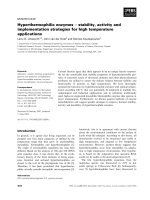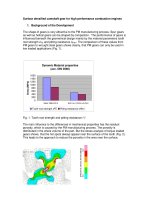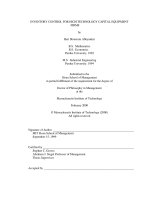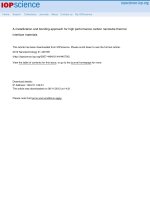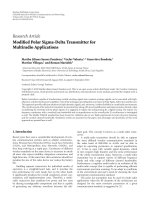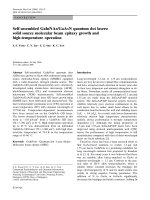Low pass sigma delta modulator for high temperature operation
Bạn đang xem bản rút gọn của tài liệu. Xem và tải ngay bản đầy đủ của tài liệu tại đây (5.26 MB, 128 trang )
Low-Pass Sigma Delta Modulator for High Temperature
Operation
GONG XIAOHUI
(B.ENG.(Hons.), NUS)
A THESIS SUBMITTED
FOR THE DEGREE OF MASTER OF ENGINEERING
DEPARTMENT OF ELECTRICAL AND COMPUTER ENGINEERING
NATIONAL UNIVERSITY OF SINGAPORE
2012
Summary
Low pass ΣΔ modulators have been applied in many applications primarily for digitizing
analog signals from environment. Compared to Nyquist rate ADCs (analog-to-digital
converter), ΣΔ ADCs have several advantages, such as high resolution and low process
influence. On the other hand, in many industrial applications such as oil drilling process
and hybrid vehicles, the electronic control circuits are required to operate at high
temperature environment (typically above 200 oC), in which the commercial circuits are
not capable of. This requires special design considerations dedicated for high temperature
environment.
In this work, a design of 3rd-order ΣΔ modulator has been presented in details. It is
capable to operate in high temperature environment (above 200 oC). The input signal
bandwidth is 250 Hz and sampling frequency is 128 kHz. It applies switched capacitor
CIFB architecture with additional feed forward path to minimize the signal swing of
internal stages. Meanwhile, by applying several high temperature design techniques,
issues caused by the decrease of mobility and threshold voltage have been resolved. Over
the temperature range from 0 oC to 300 oC, the designed fully differential amplifier shows
a steady gain above 63dB and the overall system achieves a steady SNR of 87 dB.
i
Acknowledgement
First of all, I would like to thank my supervisor, Professor Xu Yong Ping, for his valuable
guidance and help during the course of this project. His expertise in circuit design and
measure greatly helped me overcome the obstacles to accomplish this work. Thanks for all
his effort in teaching and guiding me in the progress of this project.
I would also like to thank Ms. Zheng Huanqun for her effort in setting up the design tools
and debugging for system errors. Thank Mr. Teo Seow Miang for his effort in maintaining
and supporting the test equipment.
Besides, I would like to thank all the friends in VLSI lab for the inspiring discussions and
sharing of knowledge. I really appreciate their help in their advice and effort for troubleshooting.
ii
Table of Contents
Summary ........................................................................................................................... i
Acknowledgement ............................................................................................................ ii
List of Figures .................................................................................................................... vii
List of Tables...................................................................................................................... xii
Chapter 1 Introduction ......................................................................................................... 1
1.1 Background ................................................................................................................ 1
1.2 Thesis Organization .................................................................................................... 2
Chapter 2 Fundamentals of A/D Conversion and ΣΔ Modulation ....................................... 4
2.1 Concept of Sampling .................................................................................................. 4
2.2 Quantization ............................................................................................................... 6
2.3 Introduction to ADCs ................................................................................................. 8
2.3.1 Nyquist Rate ADC ............................................................................................... 8
2.3.2 Oversampling ADCs ............................................................................................ 9
2.3.3 ΣΔ ADC ............................................................................................................. 10
2.4 Fundamentals of ΣΔ modulator ............................................................................ 13
2.5 Parameters and Classification of ΣΔ modulator ................................................... 14
2.5.1 Design Parameters of ΣΔ modulator .................................................................. 14
2.5.2 Classification of ΣΔ modulator .......................................................................... 17
iii
2.6 Stability issue ........................................................................................................... 17
2.7 Noise analysis ........................................................................................................... 19
2.7.1 Flicker Noise ...................................................................................................... 20
2.7.2 Thermal noise .................................................................................................... 20
2.8 Performance Metrics ................................................................................................ 21
Chapter 3 High Temperature Circuit Design ..................................................................... 24
3.1 Background .............................................................................................................. 24
3.2 Temperature Effect on Threshold Voltage ............................................................... 24
3.3 Temperature Effect on Mobility ............................................................................... 26
3.4 Temperature Effect on Passive Components ............................................................ 29
3.6.1 Zero temperature coefficient biasing ................................................................. 31
3.6.2 Constant gm (transconductance) biasing circuit: ............................................... 34
3.6.3 Resistor Temperature Coefficients Cancelling .................................................. 36
Chapter 4 Switched Capacitor Circuit Fundamentals ........................................................ 39
4.1 Concept of Switched Capacitor Circuit .................................................................... 39
4.2 CMOS Switches ....................................................................................................... 40
4.3 Non-Ideal Effects of CMOS Switches ..................................................................... 42
4.3.1 Charge Injection ................................................................................................. 42
4.3.2 Clock Feedthrough ............................................................................................. 43
4.3.3 Bottom plate sampling technique ...................................................................... 44
iv
4.4 Switched capacitor integrator ................................................................................... 44
4.4.1 Switched Capacitor Integrator Operation Principle ........................................... 44
4.4.2 Non-ideality due to finite gain of amplifier ....................................................... 48
Chapter 5 Design of High Temperature ΣΔ Modulator ..................................................... 49
5.1 Review of Previously Published High Temperature ΣΔ Modulators ....................... 49
5.2 System Level Design of Sigma Delta Modulator ..................................................... 54
5.2.1 MatLab Model Construction and Simulation .................................................... 55
5.2.2 SimuLink Model Construction and Optimization ............................................. 58
Chapter 6 Circuit Implementation...................................................................................... 61
6.1 Top Level Circuit Schematic .................................................................................... 61
6.2 Sizing the capacitor .................................................................................................. 62
6.3 Design of Fully differential Amplifier ..................................................................... 62
6.3.1 Analysis of Folded cascode amplifier ................................................................ 63
6.3.2 Two-Stage amplifier .......................................................................................... 64
6.3.3 Common-Mode Feedback.................................................................................. 65
6.4 Clock generator ........................................................................................................ 79
6.4.1 Clock Scheme .................................................................................................... 79
6.4.2 Clock generator .................................................................................................. 81
6.4.3 Simulation Result of Clock generator ................................................................ 82
6.5 Comparator ............................................................................................................... 84
v
6.5.1 Comparator Circuit Schematic........................................................................... 84
6.5.2 Simulation Result of Comparator ...................................................................... 85
6.5.3 Output Latch Schematic..................................................................................... 85
6.5.4 Simulation Results of Comparator with Output Latch ...................................... 86
6.6 Post-Layout Simulation result and discussion .......................................................... 87
6.7 Measurement Results ............................................................................................... 91
6.8 Result Analysis and Discussion ............................................................................... 97
6.8.1 SNDR drop ........................................................................................................ 97
6.8.2 3rd-Order Harmonics .......................................................................................... 98
6.8.3 Comparison with previously reported works ................................................... 101
Chapter 7 Conclusion ....................................................................................................... 102
7.1 Conclusion .............................................................................................................. 102
7.2 Future work ............................................................................................................ 102
Bibliography ................................................................................................................. 104
Appendix A MatLab Scripts for Modeling the Modulator.......................................... 109
Appendix B Ocean Script ............................................................................................ 113
vi
List of Figures
Figure 1-1 Electrical System ................................................................................................ 1
Figure 2-1 Nyquist Sampling Theorem ............................................................................... 5
Figure 2-2 Nyquist Rate ADC.............................................................................................. 5
Figure 2-3 Concept of quantizer .......................................................................................... 7
Figure 2-4 3-bit flash ADC schematic ................................................................................. 8
Figure 2-5 Oversampling ADC ............................................................................................ 9
Figure 2-6 Quantization noise PSD of Nyquist rate (a) and oversampling (b) ADCs ....... 10
Figure 2-7 ΣΔ ADC block diagram .................................................................................... 11
Figure 2-8 Linear model of ΣΔ modulator ......................................................................... 11
Figure 2-9 Comparison of Nyquist ADCs, oversampling ADCs and ΣΔ ADCs .............. 12
Figure 2-10 1st-order single loop ΣΔ modulator block diagram ........................................ 13
Figure 2-11 2nd order ΣΔ modulator block diagram .......................................................... 14
Figure 2-12 PSD of NTF (Z) for 1st-order (MOD1) and 2nd order (MOD2) modulators .. 16
Figure 2-13 Empirical SNR limits for quantization bits =1 (a) and 2(b) .......................... 17
Figure 2-14 Noise PSD profile ........................................................................................... 19
Figure 2-15 Thermal Noise Model of NMOS transistor .................................................... 21
Figure 2-16 Definitions of maximum SNR and DR .......................................................... 22
Figure 2-17 Harmonic distortion........................................................................................ 23
Figure 3-1 Simulation of Vth against temperature .............................................................. 26
Figure 3-2 Simulation of mobility against temperature ..................................................... 28
Figure 3-3 Plot resistance against temperature .................................................................. 29
Figure 3-4 Cross section of bulk CMOS inverter (A) and SOI CMOS inverter (B) ........ 30
vii
Figure 3-5 Simulated drain current under DC sweep of gate voltage at different
temperatures ....................................................................................................................... 32
Figure 3-6 Transistor biased at ZTC biasing point ............................................................ 33
Figure 3-7 Constant gm biasing circuit .............................................................................. 34
Figure 3-8 Constant gm biasing circuit with start-up transistor......................................... 36
Figure 3-9 Series connection of two resistors with different TC ....................................... 37
Figure 3-10 Simulation of Rtotal.......................................................................................... 38
Figure 4-1 Switched capacitor circuit ................................................................................ 39
Figure 4-2 NMOS switch (a) and transmission gate switch (b) ......................................... 41
Figure 4-3 On-resistance of transmission gate switch ....................................................... 42
Figure 4-4 Charge injection of MOS switch ...................................................................... 43
Figure 4-5 Clock feed through of MOS switch .................................................................. 43
Figure 4-6 Bottom plate sampling techniques ................................................................... 44
Figure 4-7 RC integrator schematic ................................................................................... 45
Figure 4-8 Switched capacitor integrator ........................................................................... 46
Figure 4-9 Clock phase 1 ................................................................................................... 46
Figure 4-10 Clock phase 2 ................................................................................................. 47
Figure 5-1 System schematic of a 2nd order single stage modulator and ........................... 49
Figure 5-2 System schematic of a 2nd-order single stage modulator and ........................... 52
Figure 5-3 High temperature data acquisition system block diagram................................ 54
Figure 5-4 Poles and zeros of NTF (Z) .............................................................................. 56
Figure 5-5 NTF (green) and PSD (blue) of transfer function simulation .......................... 57
Figure 5-6 Full CIFB architecture ...................................................................................... 57
viii
Figure 5-7 Finalized modulator block diagram .................................................................. 59
Figure 5-8 PSD of SimuLink model simulation ................................................................ 60
Figure 6-1 Modulator schematic ........................................................................................ 61
Figure 6-2 Schematic of folded cascode fully differential amplifier ................................. 63
Figure 6-3 Schematic of two stage fully differential amplifier .......................................... 65
Figure 6-4 Concept of common-mode (CM) feedback ...................................................... 66
Figure 6-5 Circuit which calculates the output common-mode voltage ............................ 66
Figure 6-6 Switched capacitor based CMFB circuit .......................................................... 67
Figure 6-7 Voltage droop of switched capacitor voltage ................................................... 68
Figure 6-8 Continuous-time CMFB circuit ........................................................................ 69
Figure 6-9 Two stage fully differential amplifier with single CMFB loop........................ 70
Figure 6-10 Two stage fully differential amplifier with double CMFB loops ................... 71
Figure 6-11 Block diagram of single loop CMFB topology .............................................. 72
Figure 6-12 DC level of 1st stage output at different temperatures .................................... 72
Figure 6-13 Biasing circuit ................................................................................................ 73
Figure 6-14 Simulated total resistance ............................................................................... 74
Figure 6-15 Final schematic of amplifier ........................................................................... 75
Figure 6-16 Transient plot of amplifier at different temperatures ..................................... 76
Figure 6-17 Output DC levels of 1st and 2nd stages at different temperatures ................... 76
Figure 6-18 Gain and phase plot at 0 oC ............................................................................ 77
Figure 6-19 Gain and phase plot at 120 oC ........................................................................ 77
Figure 6-20 Gain and phase plot at 225 oC ........................................................................ 78
Figure 6-21 Amplifier power consumption at different temperatures ............................... 79
ix
Figure 6-22 Integrator schematic ....................................................................................... 80
Figure 6-23 Non-overlapping clock waveform .................................................................. 80
Figure 6-24 Non-overlapping with delayed clock waveform ............................................ 81
Figure 6-25 Clock generator schematic ............................................................................. 81
Figure 6-26 Delays of NAND gate (a) and inverter (b) ..................................................... 83
Figure 6-27 Clock generator output waveform .................................................................. 83
Figure 6-28 Schematic of comparator ................................................................................ 84
Figure 6-29 Comparator output waveform ........................................................................ 85
Figure 6-30 Output latch schematic ................................................................................... 86
Figure 6-31 Output waveform of comparator with output latch ........................................ 87
Figure 6-32 Modulator layout ............................................................................................ 88
Figure 6-33 PSD of post layout simulation at different temperatures ............................... 89
Figure 6-34 Dynamic range plot ........................................................................................ 89
Figure 6-35 Measurement Setup Diagram ......................................................................... 91
Figure 6-36 Measured PSDs at different temperatures ...................................................... 92
Figure 6-37 Measured PSDs at different temperatures for low input amplitude where
distortions are not seen ....................................................................................................... 92
Figure 6-38 Measured PSDs for different input amplitude at 25 oC .................................. 93
Figure 6-39 Measured PSDs for different input amplitude at 150 oC ................................ 93
Figure 6-40 Measured PSDs for different input amplitude at 200 oC ................................ 94
Figure 6-41 Measured PSDs for different input amplitude at 250 oC ................................ 94
Figure 6-42 Measured PSDs for different input amplitude at 300 oC ................................ 95
Figure 6-43 Measured peak SNR at different temperatures............................................... 95
x
Figure 6-44 Measured SNR against input amplitude at different temperatures................. 96
Figure 6-45 PSD simulated with behavior model of amplifier .......................................... 98
Figure 6-46 PSD simulated with ideal capacitor.............................................................. 100
xi
List of Tables
Table 2-1 Classification of ΣΔ modulators ........................................................................ 17
Table 5-1 Amplifier open-loop gain at different temperatures ......................................... 50
Table 5-2 Experimental SNDR at different temperatures and input amplitudes .............. 50
Table 5-3 Summary of measurement results ..................................................................... 52
Table 5-4 Design Specification .......................................................................................... 54
Table 5-5 Calculated unscaled coefficients........................................................................ 58
Table 5-6 Finalized coefficients after scaling .................................................................... 59
Table 6-1 Amplifier AC performace .................................................................................. 78
Table 6-2 Clock generator timing table ............................................................................. 82
Table 6-3 Summary of key performance parameters ......................................................... 90
Table 6-4 Modulator Measurement Result Summary ........................................................ 96
Table 6-5 Performance Comparison between this work and reported works .................. 101
xii
Chapter 1 Introduction
1.1 Background
In recent years, following the rapid development of semiconductor industry, electronics
have been adopted in various applications. For typical applications such as consumer
electronic products, home appliances, bio-medical devices and automated manufacturing
machines, functional specific electrical systems are designed to monitor and control the
operation. Generally, such systems sense the physical signals using a sensor and feed the
sensed electrical signals to the processor. The processor processes the sensed data based
on application specific algorithms and sends control signal to the actuator which performs
the operation back [1]. This is explained in Figure 1-1.
Figure 1-1 Electrical System
Among various steps in the process, sensing has always been a crucial step since the
quality of the sensed data directly affects the system performance. Generally, for a sensor,
the sensing quality is usually relied on an analog-to-digital converter(ADC), which
converts the input signals(usually come in an analog format, such as sound, temperature,
light and so on) into digital signals in order to be processed by the processor. In many
applications, high resolution of A/D conversion is required, which leads to the promotion
1
of ΣΔ ADC. It applies ΣΔ modulation techniques and is able to achieve a resolution as
high as above 16-bit ENOB [2].
On the other hand, operating temperature is a major limitation for the performance of
electronic circuits that operate in harsh environments. This is because many physical
parameters of silicon such as carrier concentrations and carrier mobilities, vary as
temperature changes. This implies that electronic circuit is dedicated to operate within a
pre-defined temperature range. Generally, for commercial electronic circuits, the
operating temperature is within the range of 0 oC to 85 oC. For military applications, the
operating temperature is within the range of -55 oC to 125 oC [3]. However, there is an
increasing demand [4] [5] [6] of circuits which works in a wider temperature range. For
example, in many industrial applications, such as oil drilling, aerospace and hybrid
vehicles, circuits are required to operate in the temperature as high as above 200 oC [7], in
which the available circuits are not capable of.
1.2 Thesis Organization
As motivated by the above mentioned demand of high temperature circuits, this work
presents a switched capacitor based high temperature low pass ΣΔ modulator. Chapter 2
introduces the fundamentals of A/D conversion and the operational principle of ΣΔ
modulator.
Chapter 3 studies the high temperature issues which may affect the circuit performance.
Some effective high temperature design techniques are introduced to minimize the high
2
temperature effects. In addition, a study of SOI CMOS process fundamentals is also
presented.
Chapter 4 introduces the fundamental concepts of switched capacitor circuits. The issues
associated with CMOS switch are studied in detail. Techniques such as bottom plate
sampling are introduced in order to minimize the non-ideal effects. Moreover, a switched
capacitor based integrator is studied in details and the transfer function is derived.
Chapter 5 firstly reviews some previously reported designs and analyzes the pros and cons
of individual design. Subsequently, a top-level design of high temperature low pass ΣΔ
modulator is presented. With the proposed specification, the system level design and
modeling is done using MatLab.
Chapter 6 presents the circuit level implementation of the low pass ΣΔ modulator. The
details of every circuit block are shown together with the simulation results. In addition,
the post-layout simulation result is shown. Discussion and analysis of the performance are
also presented.
Chapter 7 summarized the major achievements of this work. Some suggestions on future
improvement have been proposed.
3
Chapter 2 Fundamentals of A/D Conversion and
ΣΔ Modulation
2.1 Concept of Sampling
An analog-to-digital converter is a circuit block that converts the continues-time (analog)
signal into discrete-time (digital) signal. According to the Nyquist sampling theory, in
order to reconstruct the input signal with no error, the sampling frequency fs must be at
least twice of the input signal bandwidth fB, which is given by
The sampling frequency fs, which equals to twice of fB, is called Nyquist sampling rate.
The Nyquist sampling theory can be explained in Figure 2-1. Theoretically, the input
signal spectrum with bandwidth of fB is shown in Figure 2-1a, which is symmetric about
the y axis. After being sampled, the spectrum is copied and shifted to be centered at fs, 2fs,
3fs and so on as shown in Figure 2-1b. Therefore, for fs less than twice of fB, the two
adjacent spectrums will overlap near the end of the band, which distorts the original signal
spectrum. This is shown in Figure 2-1c. In this case, the original signal spectrum can
never be reconstructed error-freely. This overlapping of spectrums is called aliasing.
However, as shown in Figure 2-1d, when Nyquist sampling rate is used, there is an
enough gap between two adjacent spectrums. It ensures that the signal spectrum is not
distorted so that the original signal can be recovered by an anti-aliasing filter [8].
4
Figure 2-1 Nyquist Sampling Theorem
There are different types of ADCs. However, based on the sampling frequency, they can
be divided into two categories, namely Nyquist rate ADCs and oversampling ADCs. For a
Nyquist rate ADC, the sampling frequency is twice of the input single bandwidth. In real
application, however, a sampling frequency slightly higher than Nyquist sampling rate is
selected in order to ease the performance requirement of anti-aliasing filter. An example is
shown in Figure 2-2.
Figure 2-2 Nyquist Rate ADC
5
2.2 Quantization
Quantization is a process to convert the analog signal into digital signal, as depicted in
Figure 2-2. For an N bit quantizer, the output signal can have 2N levels as shown in Figure
2-3. However, since the quantization levels are discrete and finite, the quantization
process is embedded with quantization noise. Generally, for an N bit quantizer, the step
size can be expressed as equation (2.1) [9], which correspond to one LSB (Least
Significant Bit). For large value of N, the step size can be approximated to FS/2N. As
shown in Figure 2-3, when the input analog signal sweeps from the minimum value to
maximum value, the instantaneous quantization error ranges from -0.5LSB to +0.5LSB.
As shown in (2.2), by applying a linear model of the quantization process, with input of x,
the quantization error e is a simple addition to the output y. Hence, the quantization error
is approximated as white noise with zero mean [10]. Therefore, the variance, which
corresponds to the power of the quantization error, can be expressed as equation (2.3) [11].
Furthermore, for a full scale sinusoidal input, the peak SNR (signal to noise ratio) can be
expressed as equation (2.4). As a key performance parameter of ADC, a high SNR has
been a challenge for ADC design [9].
Where
x is the input analog signal
k is the coefficient corresponding to the slope of line l as shown in Figure 2-3a
e is the quantization error
y is the output digital signal
6
Figure 2-3 Concept of quantizer
7
2.3 Introduction to ADCs
2.3.1 Nyquist Rate ADC
There are many types of Nyquist rate ADCs. For example, flash ADC, as shown in Figure
2-4 [12], uses resistors chain to divide the reference voltage Vref into eight voltages (0V,
Vref /7, 2Vref /7, 3Vref /7 … Vref). If the input voltage is 0.5Vref, it is higher than 3Vref /7 and
lower than 4Vref /7. Those comparators which connect to Vref /7, 2Vref /7 and 3Vref /7
output 1 and the rest output 0. The encoder finally encodes the comparators output to
binary code 3’b011.
Figure 2-4 3-bit flash ADC schematic
8
In a practical flash ADC as well as other Nyquist rate ADCs, in order to achieve a good
linearity and high SNR, the matching of the circuit elements (resistors, capacitors or
transistors) must be accurate. However, due to some conditions, such as process variation
and parasitic, the inaccuracy is limited to above 0.02%. In another word, the maximum
achievable SNR is less than 80 dB.
2.3.2 Oversampling ADCs
An oversampling ADC samples the input signal at a frequency much higher that the
Nyquist sampling rate. The OSR (oversampling ratio) is defined as equation (2.5). As
depicted in Figure 2-5, the ADC samples the input signal at a frequency of fs. After
quantization and filtering, the output digital signal goes through a down-sampling process
to Nyquist rate.
Figure 2-5 Oversampling ADC
The oversampling ADC with N-bit quantizer contributes the same total quantization noise
power as a Nyquist rate ADC with a same quantizer does. As explained in Figure 2-6a, the
9
total quantization noise power is evenly distributed between -fB and fB for a Nyquist rate
ADC. Therefore, the in-band quantization noise power is equivalent to the total
quantization noise power. As shown in Figure 2-6b, for an oversampling ADC, since the
sampling frequency is increased to fs, the same amount of total quantization noise power
spreads from -fs to fs. Therefore, the quantization noise level is lowered and the in-band
quantization noise power is decreased. The in-band quantization noise power is expressed
as equation (2.6). Hence, the SNR is derived as shown in (2.7). As a general rule of thumb,
for every doubling of the OSR, the SNR increases by 3 dB (ENOB increases for 0.5b).
Figure 2-6 Quantization noise PSD of Nyquist rate (a) and oversampling (b) ADCs
2.3.3 ΣΔ ADC
A ΣΔ ADC is built on top of oversampling ADC. The main difference is that the original
quantizer is replaced by a ΣΔ modulator, as shown in Figure 2-7. Generally, a ΣΔ
10
modulator consists of a loop filter, a quantizer and a DAC (digital-to-analog converter).
Instead of digitizing the input signal directly, it integrates (low pass filtering) the error
between the input and output signals, digitizes the integrated signal and feedbacks to input
again. A linear model of discrete-time ΣΔ modulator is shown in Figure 2-8.
Figure 2-7 ΣΔ ADC block diagram
Figure 2-8 Linear model of ΣΔ modulator
In this linear model, the loop filter’s transfer function is H(Z). The quantizer is modeled as
an ideal quantizer with quantization noise E(Z) as suggested in equation (2.1). The output
11
